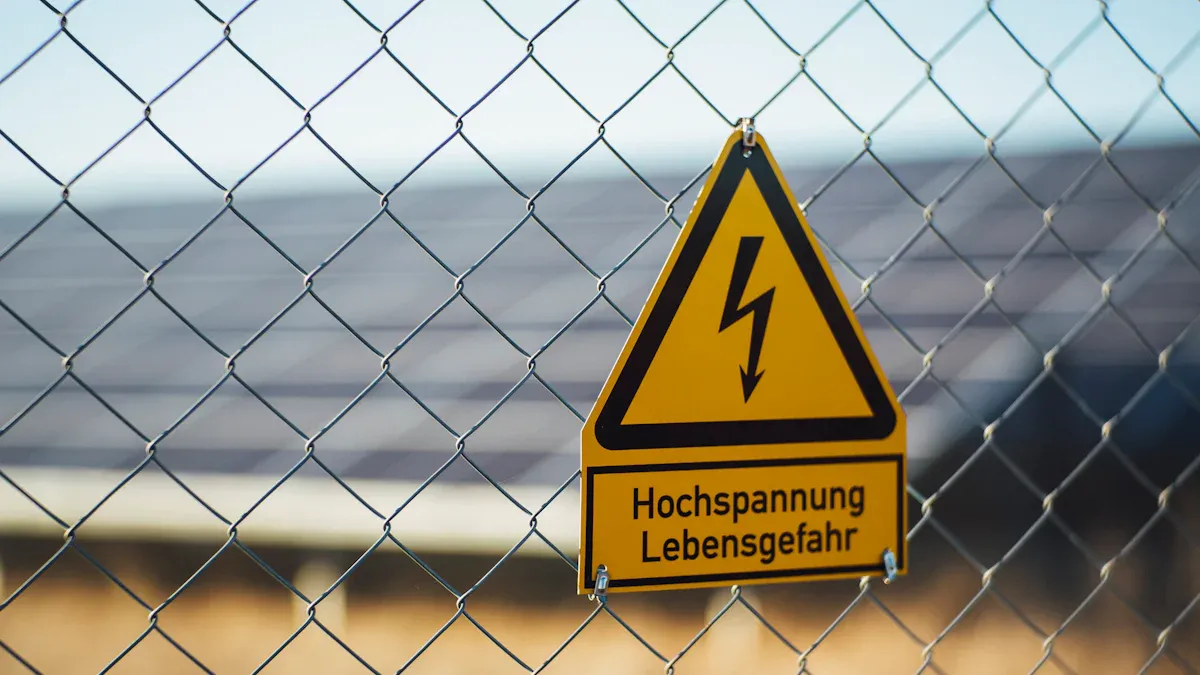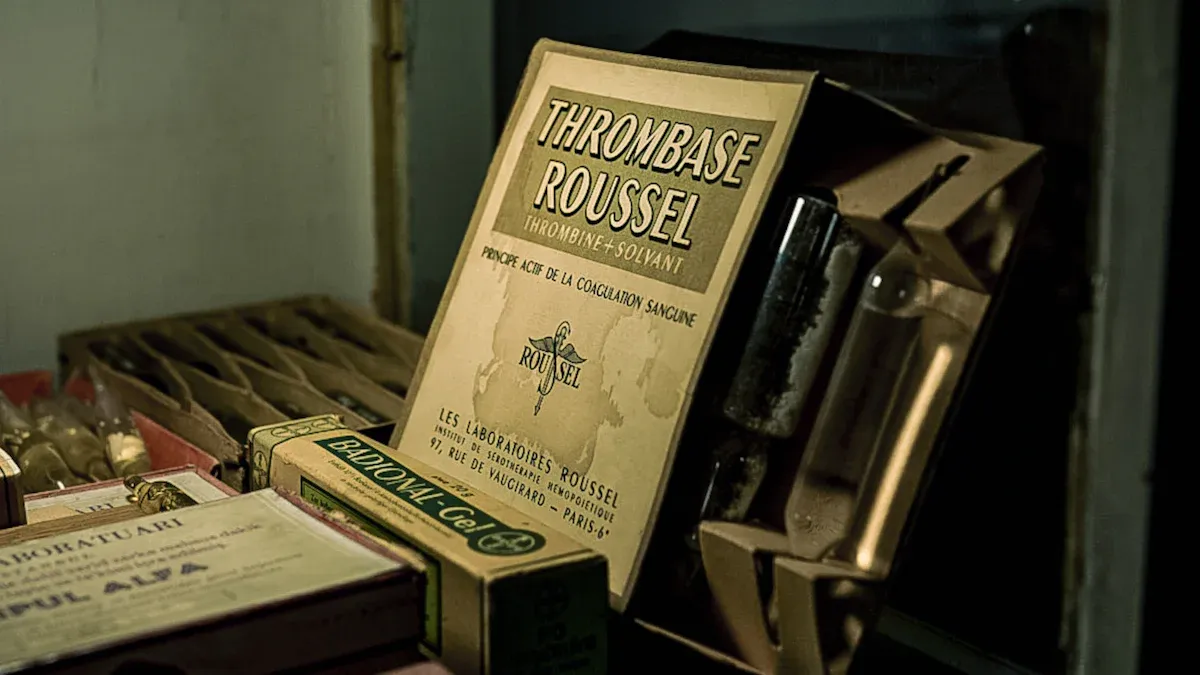How to Store Flashlight Batteries to Prevent Drainage

Have you ever grabbed your flashlight during an emergency, only to find the batteries drained? Proper storage can prevent this frustrating scenario. By taking simple steps, you can avoid issues like leakage or swelling. Whether you're flashlight using for camping or power outages, keeping batteries in good condition ensures it's always ready when you need it.
Key Takeaways
Keep batteries in a cool, dry spot to last longer.
Take batteries out of gadgets when unused to stop leaks.
Check batteries often for leaks or rust to stay safe.
Why Proper Battery Storage Matters
Consequences of Improper Battery Storage
Improper battery storage can lead to several problems that you definitely want to avoid. For starters, environmental conditions like extreme heat or cold can damage your batteries. This reduces their lifespan and makes them less reliable when you need them most. If you store batteries in humid areas, they might corrode or leak harmful chemicals. These leaks can contaminate groundwater and even pose health risks due to exposure to carcinogens like nickel and cadmium.
Another issue is safety. Batteries stored carelessly can become unstable, especially lithium-ion ones. This instability might lead to fires, which are dangerous at home and in landfills. Plus, if you mix old and new batteries or leave them in devices for too long, you risk swelling or deformation. These problems not only ruin the batteries but can also damage your flashlight.
Benefits of Proper Battery Storage
When you store batteries properly, you’re setting yourself up for success. First, proper battery storage extends the lifespan of your batteries. This means they’ll perform better and last longer, saving you money in the long run. It also prevents accidents, like leaks or fires, keeping your home and loved ones safe.
Good storage practices also help the environment. By reducing the chances of leaks or fires, you minimize pollution and health risks. Using quality storage cases or the original packaging ensures your batteries stay in top condition. Plus, following best practices optimizes performance, so your flashlight is always ready when you need it.
Tip: Always store batteries in a cool, dry place and check them regularly for signs of damage. A little effort goes a long way in keeping them safe and functional.
Best Practices for Storing Batteries

Store Batteries in a Cool, Dry Place
To extend battery life and maintain their shelf life, always store batteries in a cool and dry place. Heat and humidity can damage batteries, reducing their performance and longevity. The ideal temperature for storing batteries is around 15°C (59°F), but room temperature (15–25°C or 59–77°F) works well too. Avoid areas like attics or basements where temperatures can fluctuate. A dry and well-ventilated place, such as a drawer or cabinet, is perfect for keeping your batteries safe and functional.
Avoid Contact with Metal Objects
When you store batteries safely, keep them away from metal objects like coins, keys, or tools. Metal can cause a short circuit, which may damage the battery or even lead to overheating. To prevent this, use non-metallic containers or the original packaging. This simple step helps conserve battery life and ensures your batteries stay in good condition.
Use Original Packaging or Battery Cases
The original packaging or a dedicated battery case is your best friend when it comes to storing batteries. These options protect batteries from dust, moisture, and accidental contact with other objects. They also help you organize your batteries, making it easier to find the right one when needed.
Remove Batteries from Flashlights When Not in Use
If you’re not using your flashlight for a while, remove the batteries from devices. This prevents parasitic drain, which can slowly deplete battery power even when the flashlight is off. By doing this, you’ll keep your batteries fresh and ready for emergencies. It’s a simple habit that can significantly extend battery life.
Keep Batteries Away from Extreme Temperatures
Extreme temperatures can wreak havoc on batteries. Cold temperatures can cause lithium plating, reducing capacity and posing safety risks. On the other hand, heat accelerates chemical reactions, leading to faster self-discharge and potential hazards like thermal runaway. Always store batteries in a cool, dry, and well-ventilated place to avoid these issues. This practice is key to maximizing battery life and ensuring safety.
Common Mistakes to Avoid in Battery Storage
Mixing Old and New Batteries
Mixing old and new batteries in your flashlight might seem harmless, but it can cause problems. Old batteries have a lower charge, which forces the new ones to work harder. This imbalance can lead to overheating or even leakage. Always separate different types of batteries and replace all batteries in your flashlight at the same time. This ensures consistent performance and prevents unnecessary damage.
Storing Batteries in Humid or Hot Environments
Humidity and heat are your batteries’ worst enemies. High temperatures speed up chemical reactions inside the battery, increasing the self-discharge rate. This means your batteries lose power even when not in use. Heat can also cause the battery fluid to evaporate, damaging its internal structure permanently. To avoid this, keep your batteries in a cool, dry place. Avoid direct sunlight and never leave them in hot spaces like a car. If you live in a warm climate, consider using insulated cases to protect your batteries from heat.
Leaving Batteries in Flashlights for Long Periods
Leaving batteries in your flashlight for too long can lead to parasitic drain. Even when the flashlight is off, it can slowly draw power from the batteries. Over time, this can leave you with dead batteries when you need them most. Worse, if the batteries leak, they can damage your flashlight. Always remove batteries if you’re not planning to use the flashlight for a while. It’s a small step that can save you from big headaches later.
Using Damaged or Expired Batteries
Using damaged or expired batteries is risky. Damaged batteries can leak or overheat, posing safety hazards. Expired batteries often have a higher self-discharge rate, making them unreliable. Check your batteries regularly for signs of damage, like corrosion or swelling. If you notice anything unusual, dispose of the batteries properly. For rechargeable batteries, follow special considerations for rechargeable batteries, such as using the correct charger and avoiding overcharging. This keeps your flashlight safe and ensures optimal performance.
Special Tips for Rechargeable Battery Storage
Store Partially Charged Batteries
When storing rechargeable batteries, keeping them partially charged is key to preserving their performance. A charge level between 40% and 60% is ideal. This range helps prevent excessive self-discharge and reduces the risk of overheating. For lithium batteries, aim for about 50% charge if you’re planning long-term storage. Storing them fully charged or completely drained can shorten their lifespan and even pose safety risks.
Tip: If you’re unsure about the charge level, many modern chargers display the battery’s status. Use this feature to ensure your batteries are stored at the right level.
Use the Correct Charger for Your Battery Type
Not all chargers are created equal. Using the wrong charger can damage your rechargeable batteries or reduce their efficiency. Always check the manufacturer’s recommendations for your battery type. For example, lithium-ion batteries require chargers designed specifically for them. A mismatched charger might overheat the battery or fail to charge it properly.
Investing in a high-quality charger can also extend battery life. Many advanced chargers come with features like overcharge protection and charge level indicators, which help you maintain your batteries in top condition.
Avoid Overcharging or Deep Discharging
Overcharging and deep discharging are two of the biggest threats to rechargeable batteries. Overcharging occurs when you leave the battery connected to the charger for too long, which can cause overheating and reduce its capacity. On the other hand, deep discharging—allowing the battery to drain completely—can lead to permanent damage.
To avoid these issues, unplug the charger once the battery is fully charged. If your charger has an auto-shutoff feature, even better! For devices you don’t use often, check the battery periodically and recharge it before it drops too low.
Rotate Rechargeable Batteries Regularly
If you have multiple rechargeable batteries, rotating them ensures even usage. This practice prevents any single battery from being overused or left idle for too long. Batteries that sit unused for extended periods may lose capacity or develop issues like swelling.
Create a simple rotation system. For example, label your batteries with numbers and use them in order. This way, you’ll keep all your batteries in good shape and ready for use when needed.
Note: Regular rotation is especially important for batteries used in high-drain devices like flashlights.
Signs of Improper Battery Storage

Leakage or Corrosion
One of the first signs of improper battery storage is leakage or corrosion. You might notice a white or bluish buildup on the battery terminals or cable ends. This often happens when batteries sit unused for too long or are exposed to moisture. Corrosion can block the flow of electricity, making your flashlight unreliable. If left unchecked, it can even lead to battery failure.
To prevent this, check your batteries regularly. Look for any signs of buildup or leaks. Cleaning the terminals with a dry cloth or a small brush can help remove early signs of corrosion. Always store your batteries in a dry place to reduce the risk of moisture damage.
Tip: If you spot any leakage, dispose of the battery safely and clean the affected area to avoid further damage.
Swelling or Deformation
Have you ever seen a battery that looks bloated or misshapen? That’s a clear sign of swelling or deformation. This usually happens when batteries are exposed to extreme heat or overcharged. Swollen batteries are not only unusable but also dangerous. They can leak harmful chemicals or even explode in rare cases.
If you notice a swollen battery, don’t try to use it. Dispose of it immediately following your local guidelines. To avoid this issue, keep your batteries away from heat sources and never overcharge them.
Reduced Battery Performance
If your flashlight dims quickly or doesn’t turn on at all, your batteries might be underperforming. This can happen when batteries are stored in poor conditions, like high humidity or fluctuating temperatures. Over time, improper storage drains their capacity, leaving you with unreliable power.
To keep your batteries performing well, store them in a cool, dry place and avoid mixing old and new ones. Regularly rotating your batteries can also help maintain their efficiency.
Remember: Proper storage isn’t just about safety—it’s also about getting the most out of your batteries.
Proper battery storage is essential for flashlight performance and safe usage. By following these storage tips, you can avoid short circuits, extend battery life, and ensure your flashlight is always ready. Use proper charging techniques, inspect batteries regularly, and keep batteries out of reach of children. These small steps make a big difference in maintaining reliability and safety.
Tip: Avoid storing discharged batteries or overcharging them. Regularly check for corrosion and clean contacts to maintain conductivity.
FAQ
How often should you check your stored batteries?
You should check your batteries every 3-6 months. Look for signs of leakage, corrosion, or swelling to ensure they remain safe and functional.
Can you store batteries in the refrigerator?
No, storing batteries in the refrigerator isn’t recommended. The moisture inside can cause corrosion or damage. A cool, dry place works best for storage.
What’s the best way to dispose of damaged batteries?
Take damaged batteries to a local recycling center or hazardous waste facility. Avoid throwing them in the trash to prevent environmental harm or safety risks.
See Also
Maximize Your Flashlight's Battery Life With These Tips
Key Strategies for Proper Flashlight Care and Maintenance
Insights Into How Rechargeable Flashlights Lose Their Charge
Comprehensive Overview of Flashlight Batteries You Should Know
